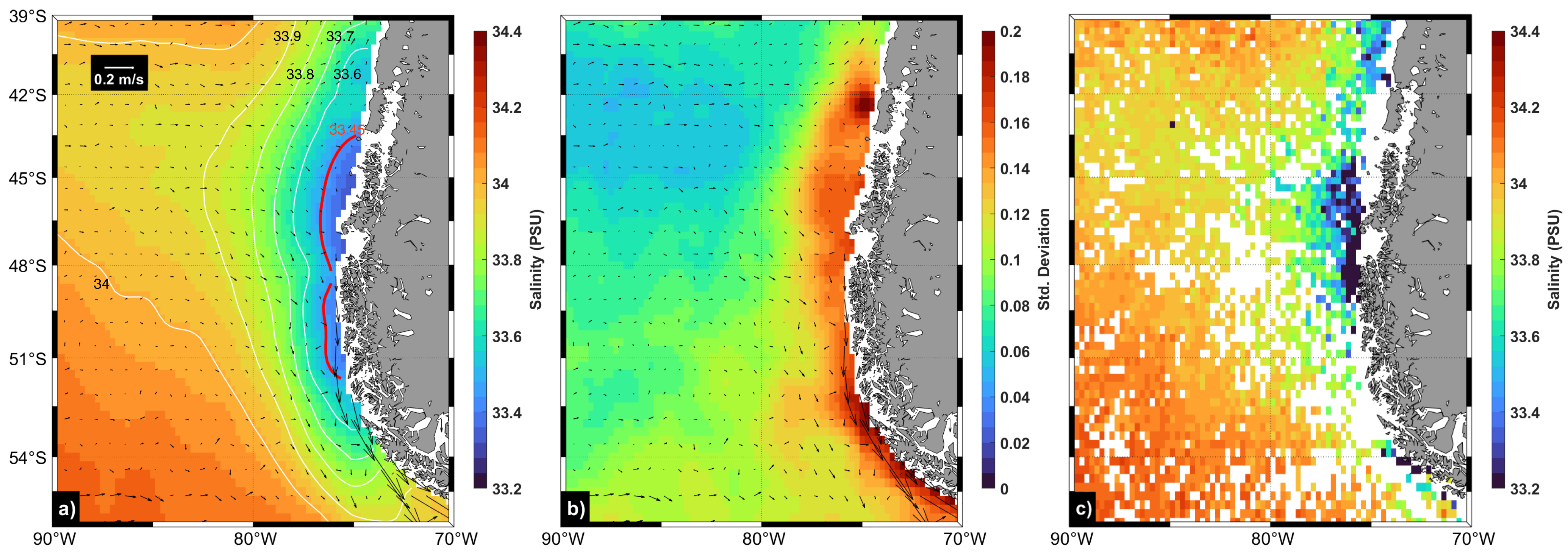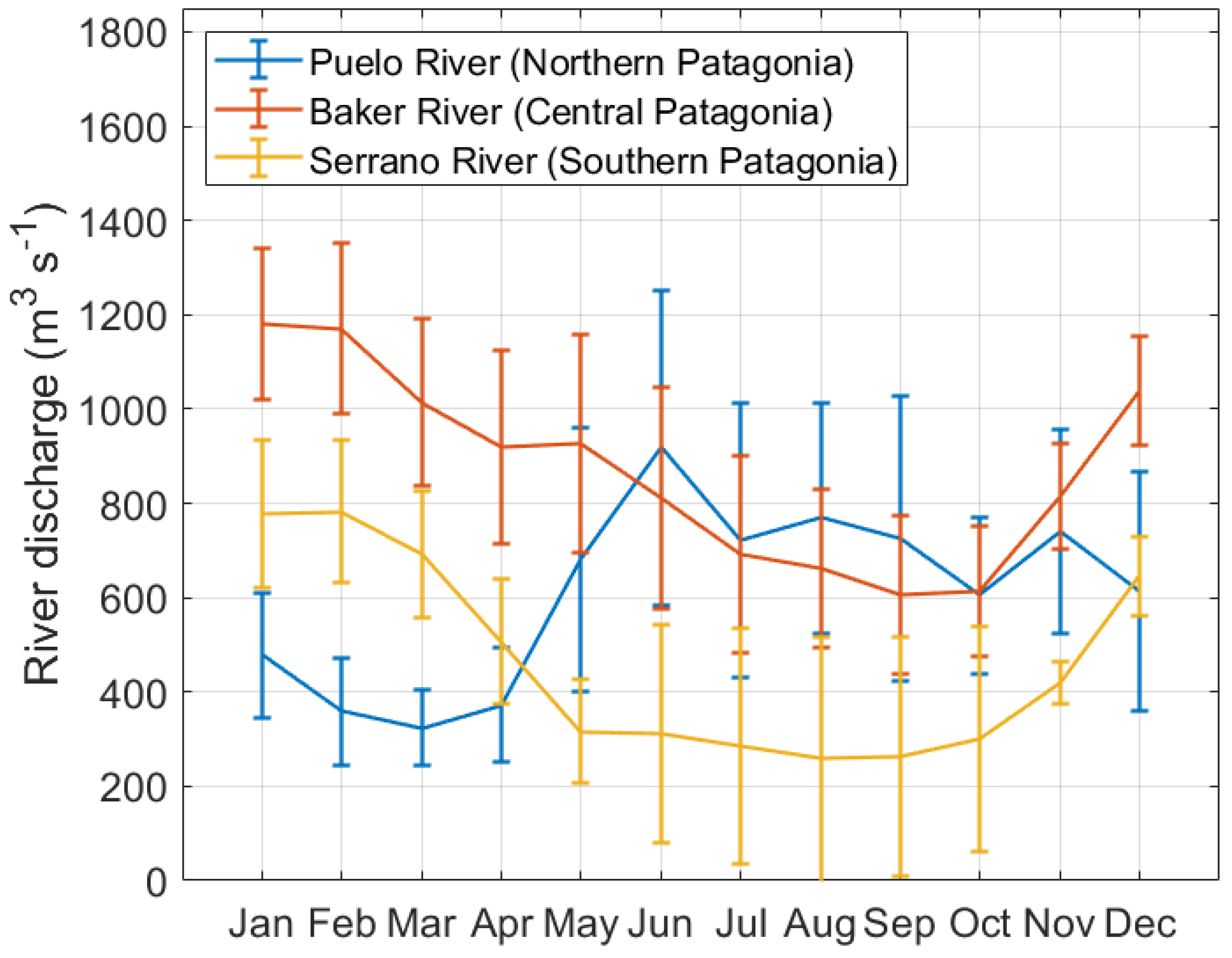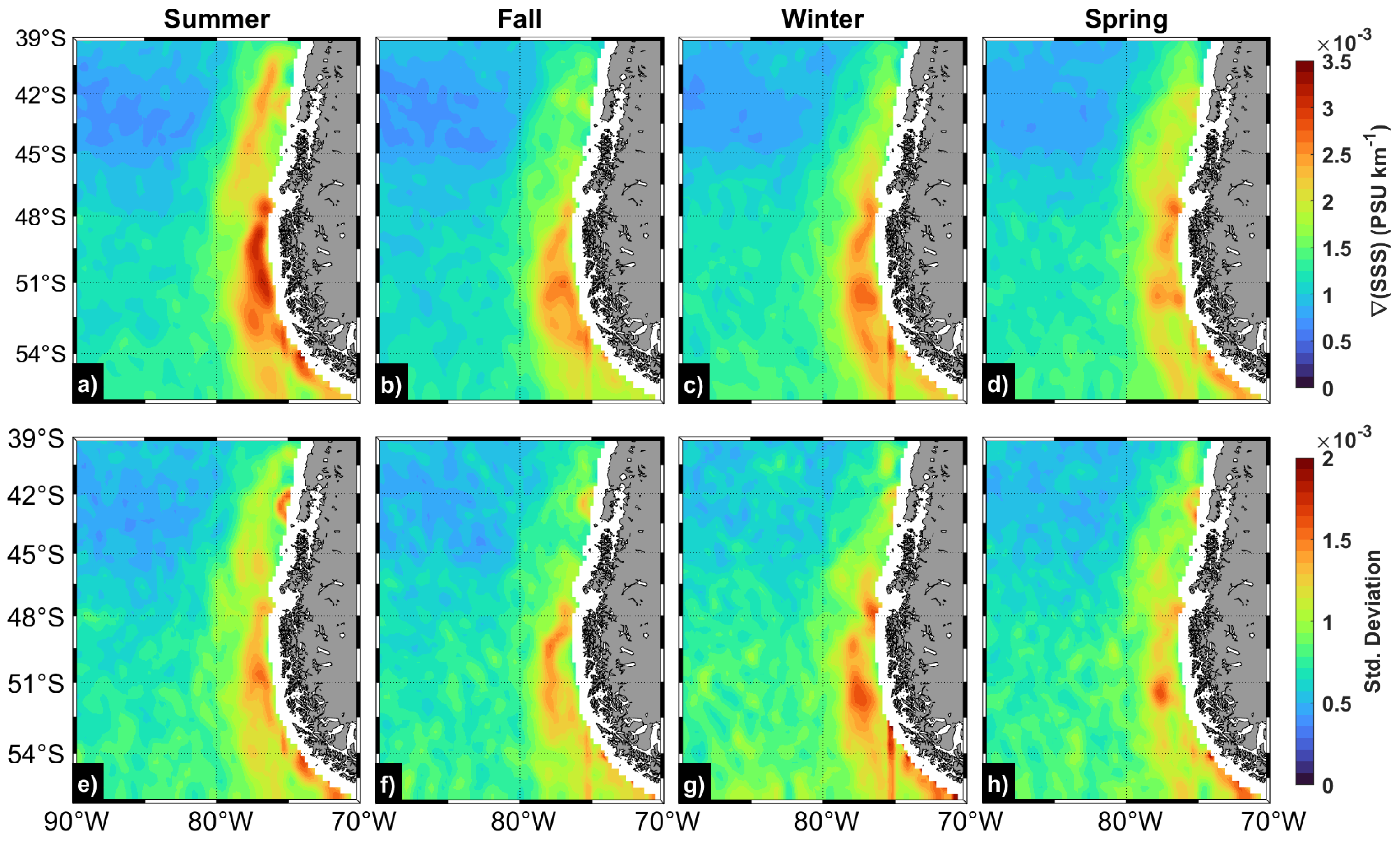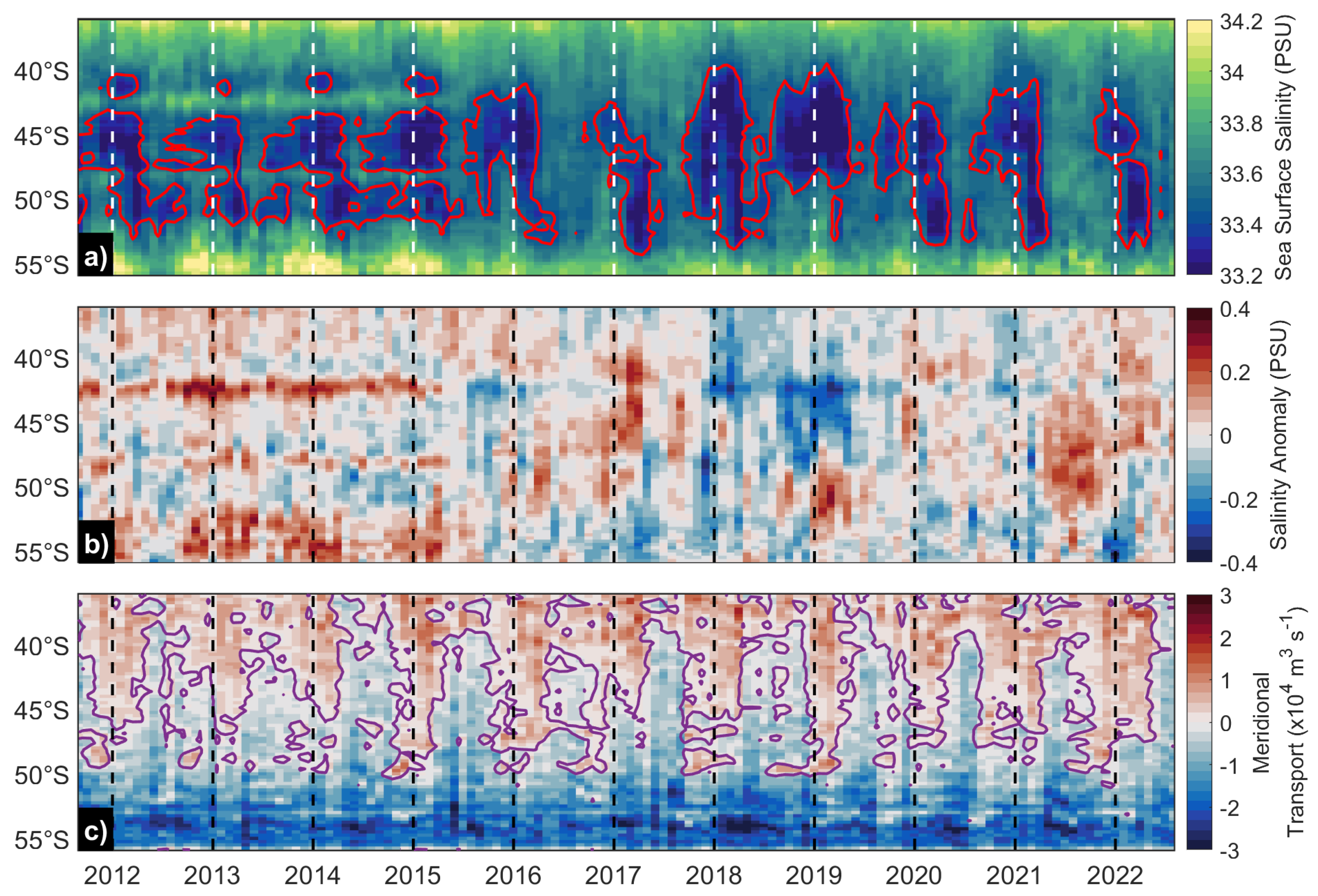Satellite-Derived Variability of Sea Surface Salinity and Geostrophic Currents off Western Patagonia
Abstract
:1. Introduction
2. Materials and Methods
2.1. Datasets
2.2. Salinity Gradients
2.3. Meridional Transports
2.4. EOF Analysis
3. Results and Discussion
3.1. Seasonal Variability of Sea Surface Salinity off Western Patagonia
3.2. Seasonal Variability of Sea Surface Salinity Gradients
3.3. Interannual Variability of SSS, Salinity Anomalies, and Meridional Geostrophic Transports
3.4. Dominant Spatio-Temporal Modes of Variability and Linear Trends
Author Contributions
Funding
Data Availability Statement
Acknowledgments
Conflicts of Interest
References
- Vinogradova, N.; Lee, T.; Boutin, J.; Drushka, K.; Fournier, S.; Sabia, R.; Stammer, D.; Bayler, E.; Reul, N.; Gordon, A.; et al. Satellite salinity observing system: Recent discoveries and the way forward. Front. Mar. Sci. 2019, 6, 428925. [Google Scholar] [CrossRef]
- Piola, A.R.; Romero, S.I.; Zajaczkovski, U. Space–time variability of the Plata plume inferred from ocean color. Cont. Shelf Res. 2008, 28, 1556–1567. [Google Scholar] [CrossRef]
- Saldías, G.S.; Largier, J.L.; Mendes, R.; Pérez-Santos, I.; Vargas, C.A.; Sobarzo, M. Satellite-measured interannual variability of turbid river plumes off central-southern Chile: Spatial patterns and the influence of climate variability. Prog. Oceanogr. 2016, 146, 212–222. [Google Scholar] [CrossRef]
- Warrick, J.A.; Farnsworth, K.L. Coastal river plumes: Collisions and coalescence. Prog. Oceanogr. 2017, 151, 245–260. [Google Scholar] [CrossRef]
- Mendes, R.; Saldías, G.S.; deCastro, M.; Gómez-Gesteira, M.; Vaz, N.; Dias, J.M. Seasonal and interannual variability of the Douro turbid river plume, northwestern Iberian Peninsula. Remote Sens. Environ. 2017, 194, 401–411. [Google Scholar] [CrossRef]
- Royer, T.C. On the effect of precipitation and runoff on coastal circulation in the Gulf of Alaska. J. Phys. Oceanogr. 1979, 9, 555–563. [Google Scholar] [CrossRef]
- Hill, A.E.; Hickey, B.M.; Shellington, F.A.; Strub, P.T.; Brink, K.H.; Barton, E.D.; Thomas, A.C. Eastern Ocean Boundaries. In The Sea: The Global Coastal Ocean, Regional Studies and Synthesis; Robinson, A.R., Brink, K.H., Eds.; John Wiley: New York, NY, USA, 1998; pp. 29–67. [Google Scholar]
- Dávila, P.M.; Figueroa, D.; Müller, E. Freshwater input into the coastal ocean and its relation with the salinity distribution off austral Chile (35–55°S). Cont. Shelf Res. 2002, 22, 521–534. [Google Scholar] [CrossRef]
- Saldías, G.S.; Sobarzo, M.; Quiñones, R. Freshwater structure and its seasonal variability off western Patagonia. Prog. Oceanogr. 2019, 174, 143–153. [Google Scholar] [CrossRef]
- Jones, E.; Anderson, L.; Jutterström, S.; Swift, J. Sources and distribution of fresh water in the East Greenland Current. Prog. Oceanogr. 2008, 78, 37–44. [Google Scholar] [CrossRef]
- Mork, M. Circulation phenomena and frontal dynamics of the Norwegian Coastal Current. Philos. Trans. R. Soc. Lond. Ser. Math. Phys. Sci. 1981, 302, 635–647. [Google Scholar]
- Royer, T.C. Coastal fresh water discharge in the northeast Pacific. J. Geophys. Res. Ocean. 1982, 87, 2017–2021. [Google Scholar] [CrossRef]
- Strub, P.T.; Mesĩas, J.; Montecino, V.; Rutlland, J.; Salinas, S. Coastal ocean circulation off western south America. In The Sea: The Global Coastal Ocean, Regional Studies and Synthesis; Robinson, A.R., Brink, K.H., Eds.; John Wiley: New York, NY, USA, 1998; pp. 273–313. [Google Scholar]
- Zheng, Q.; Bingham, R.; Andrews, O. Using Sea Level to Determine the Strength, Structure and Variability of the Cape Horn Current. Geophys. Res. Lett. 2023, 50, e2023GL105033. [Google Scholar] [CrossRef]
- Lagerloef, G.; Colomb, F.R.; Le Vine, D.; Wentz, F.; Yueh, S.; Ruf, C.; Lilly, J.; Gunn, J.; Chao, Y.; Decharon, A.; et al. The Aquarius/SAC-D mission: Designed to meet the salinity remote-sensing challenge. Oceanography 2008, 21, 68–81. [Google Scholar] [CrossRef]
- Bao, S.; Wang, H.; Zhang, R.; Yan, H.; Chen, J. Comparison of satellite-derived sea surface salinity products from SMOS, Aquarius, and SMAP. J. Geophys. Res. Ocean. 2019, 124, 1932–1944. [Google Scholar] [CrossRef]
- Melnichenko, O.; Hacker, P.; Potemra, J.; Meissner, T.; Wentz, F. Multi-Mission Sea Surface Salinity Optimum Interpolation (OISSS) Analysis Version 2.0; PODAAC: Pasadena, CA, USA, 2023. [Google Scholar]
- Nardelli, B.B.; Droghei, R.; Santoleri, R. Multi-dimensional interpolation of SMOS sea surface salinity with surface temperature and in situ salinity data. Remote Sens. Environ. 2016, 180, 392–402. [Google Scholar] [CrossRef]
- Wang, H.; Zhang, W.; Bao, S.; Chen, W.; Ren, K. Evaluation of Global Sea Surface Salinity from Four Ocean Reanalysis Products. In Proceedings of the 2022 5th International Conference on Information Communication and Signal Processing (ICICSP), Shenzhen, China, 26–28 November 2022; pp. 577–583. [Google Scholar]
- Ouyang, Y.; Zhang, Y.; Chi, J.; Sun, Q.; Du, Y. Deviations of satellite-measured sea surface salinity caused by environmental factors and their regional dependence. Remote Sens. Environ. 2023, 285, 113411. [Google Scholar] [CrossRef]
- Neshyba, S.; Fonseca, T.R. Evidence for counterflow to the west wind drift off South America. J. Geophys. Res. Ocean. 1980, 85, 4888–4892. [Google Scholar] [CrossRef]
- Galán, A.; Saldías, G.S.; Corredor-Acosta, A.; Muñoz, R.; Lara, C.; Iriarte, J.L. Argo float reveals biogeochemical characteristics along the freshwater gradient off western Patagonia. Front. Mar. Sci. 2021, 8, 613265. [Google Scholar] [CrossRef]
- Dinnat, E.P.; Le Vine, D.M.; Boutin, J.; Meissner, T.; Lagerloef, G. Remote sensing of sea surface salinity: Comparison of satellite and in situ observations and impact of retrieval parameters. Remote Sens. 2019, 11, 750. [Google Scholar] [CrossRef]
- Reul, N.; Grodsky, S.; Arias, M.; Boutin, J.; Catany, R.; Chapron, B.; d’Amico, F.; Dinnat, E.; Donlon, C.; Fore, A.; et al. Sea surface salinity estimates from spaceborne L-band radiometers: An overview of the first decade of observation (2010–2019). Remote Sens. Environ. 2020, 242, 111769. [Google Scholar] [CrossRef]
- Dossa, A.N.; Alory, G.; Da Silva, A.C.; Dahunsi, A.M.; Bertrand, A. Global analysis of coastal gradients of sea surface salinity. Remote Sens. 2021, 13, 2507. [Google Scholar] [CrossRef]
- Sun, J.; Vecchi, G.; Soden, B. Sea surface salinity response to tropical cyclones based on satellite observations. Remote Sens. 2021, 13, 420. [Google Scholar] [CrossRef]
- Melnichenko, O. Multi-Mission Optimally Interpolated Sea Surface Salinity 7-Day Global Dataset V1; PODAAC: Pasadena, CA, USA, 2021. [Google Scholar] [CrossRef]
- Melnichenko, O.; Amores, A.; Maximenko, N.; Hacker, P.; Potemra, J. Signature of mesoscale eddies in satellite sea surface salinity data. J. Geophys. Res. Ocean. 2017, 122, 1416–1424. [Google Scholar] [CrossRef]
- Hall, S.B.; Subrahmanyam, B.; Steele, M. The role of the Russian Shelf in seasonal and interannual variability of Arctic sea surface salinity and freshwater content. J. Geophys. Res. Ocean. 2023, 128, e2022JC019247. [Google Scholar] [CrossRef]
- Hoffman, E.L.; Subrahmanyam, B.; Trott, C.B.; Hall, S.B. Comparison of Freshwater Content and Variability in the Arctic Ocean Using Observations and Model Simulations. Remote Sens. 2023, 15, 3715. [Google Scholar] [CrossRef]
- Li, J.; Han, D.; Liao, G.; Zhang, T.; Ding, R.; Song, X. Dynamics of the barrier layer dipole in the equatorial Indian Ocean. J. Geophys. Res. Ocean. 2024, 129, e2023JC020479. [Google Scholar] [CrossRef]
- Yu, L. Connecting subtropical salinity maxima to tropical salinity minima: Synchronization between ocean dynamics and the water cycle. Prog. Oceanogr. 2023, 219, 103172. [Google Scholar] [CrossRef]
- Laurindo, L.C.; Siqueira, L.; Small, R.J.; Thompson, L.; Kirtman, B.P. Quantifying the contribution of ocean advection and surface flux to the upper-ocean salinity variability resolved by climate model simulations. Geophys. Res. Lett. 2024, 51, e2023GL106354. [Google Scholar] [CrossRef]
- Vazquez-Cuervo, J.; Dewitte, B.; Chin, T.M.; Armstrong, E.M.; Purca, S.; Alburqueque, E. An analysis of SST gradients off the Peruvian Coast: The impact of going to higher resolution. Remote Sens. Environ. 2013, 131, 76–84. [Google Scholar] [CrossRef]
- Saldías, G.S.; Lara, C. Satellite-derived sea surface temperature fronts in a river-influenced coastal upwelling area off central–southern Chile. Reg. Stud. Mar. Sci. 2020, 37, 101322. [Google Scholar] [CrossRef]
- Saldías, G.S.; Hernández, W.; Lara, C.; Muñoz, R.; Rojas, C.; Vásquez, S.; Pérez-Santos, I.; Soto-Mardones, L. Seasonal variability of SST fronts in the Inner Sea of Chiloé and its adjacent coastal ocean, northern Patagonia. Remote Sens. 2021, 13, 181. [Google Scholar] [CrossRef]
- Emery, W.J.; Thomson, R.E. Data Analysis Methods in Physical Oceanography, 2nd ed.; Elsevier: Amsterdam, The Netherlands, 2004. [Google Scholar]
- Flores, R.P.; Lara, C.; Saldías, G.S.; Vásquez, S.I.; Roco, A. Spatio-temporal variability of turbid freshwater plumes in the Inner Sea of Chiloé, northern Patagonia. J. Mar. Syst. 2022, 228, 103709. [Google Scholar] [CrossRef]
- Strub, P.T.; James, C.; Montecino, V.; Rutllant, J.A.; Blanco, J.L. Ocean circulation along the southern Chile transition region (38–46S): Mean, seasonal and interannual variability, with a focus on 2014–2016. Prog. Oceanogr. 2019, 172, 159–198. [Google Scholar] [CrossRef] [PubMed]
- Pérez-Santos, I.; Seguel, R.; Schneider, W.; Linford, P.; Donoso, D.; Navarro, E.; Amaya-Cárcamo, C.; Pinilla, E.; Daneri, G. Synoptic-scale variability of surface winds and ocean response to atmospheric forcing in the eastern austral Pacific Ocean. Ocean Sci. 2019, 15, 1247–1266. [Google Scholar] [CrossRef]
- Yu, L. A global relationship between the ocean water cycle and near-surface salinity. J. Geophys. Res. Ocean. 2011, 116. [Google Scholar] [CrossRef]
- Aiken, C.M. Seasonal thermal structure and exchange in Baker Channel, Chile. Dyn. Atmos. Ocean. 2012, 58, 1–19. [Google Scholar] [CrossRef]
- Ross, L.; Pérez-Santos, I.; Parady, B.; Castro, L.; Valle-Levinson, A.; Schneider, W. Glacial lake outburst flood (GLOF) events and water response in a patagonian fjord. Water 2020, 12, 248. [Google Scholar] [CrossRef]
- Silva, N.; Sievers, H.; Prado, R. Características oceanográficas y una proposición de circulación para algunos canales Australes de Chile entre 41º20′S y 46º40′S. Rev. Biol. Mar. 1995, 30, 207–254. [Google Scholar]
- Silva, N.; Rojas, N.; Fedele, A. Water masses in the Humboldt Current System: Properties, distribution, and the nitrate deficit as a chemical water mass tracer for Equatorial Subsurface Water off Chile. Deep Sea Res. Part II 2009, 56, 1004–1020. [Google Scholar] [CrossRef]
- Schneider, W.; Fuenzalida, R.; Rodríguez-Rubio, E.; Garcés-Vargas, J.; Bravo, L. Characteristics and formation of eastern South Pacific intermediate water. Geophys. Res. Lett. 2003, 30, 1581. [Google Scholar] [CrossRef]
- Linford, P.; Pérez-Santos, I.; Montes, I.; Dewitte, B.; Buchan, S.; Narváez, D.; Saldías, G.; Pinilla, E.; Garreaud, R.; Díaz, P.; et al. Recent deoxygenation of Patagonian fjord subsurface waters connected to the Peru–Chile undercurrent and equatorial subsurface water variability. Glob. Biogeochem. Cycles 2023, 37, e2022GB007688. [Google Scholar] [CrossRef]
- Pickard, G. Some physical oceanographic features of inlets of Chile. J. Fish. Board Can. 1971, 28, 1077–1106. [Google Scholar] [CrossRef]
- Sievers, H.; Silva, N. Water masses and circulation in austral Chilean channels and fjords. In Progress in the Oceanographic Knowledge of Chilean Interior Waters, from Puerto Montt to Cape Horn; Silva, N., Palma, S., Eds.; Comité Oceanográfico Nacional—Pontificia Universidad Católica de Valparaíso, Valparaíso: Valparaíso, Chile, 2008; pp. 53–58. [Google Scholar]
- Pérez-Santos, I.; Garcés-Vargas, J.; Schneider, W.; Ross, L.; Parra, S.; Valle-Levinson, A. Double-diffusive layering and mixing in Patagonian fjords. Prog. Oceanogr. 2014, 129, 35–49. [Google Scholar] [CrossRef]
- Hickey, B.M. The California current system—Hypotheses and facts. Prog. Oceanogr. 1979, 8, 191–279. [Google Scholar] [CrossRef]
- Mazzini, P.L.; Barth, J.A.; Shearman, R.K.; Erofeev, A. Buoyancy-driven coastal currents off Oregon during fall and winter. J. Phys. Oceanogr. 2014, 44, 2854–2876. [Google Scholar] [CrossRef]
- Cushman-Roisin, B.; Beckers, J.M. Introduction to Geophysical Fluid Dynamics: Physical and Numerical Aspects; Academic Press: Cambridge, MA, USA, 2011. [Google Scholar]
- Pérez-Santos, I.; Díaz, P.A.; Silva, N.; Garreaud, R.; Montero, P.; Henríquez-Castillo, C.; Barrera, F.; Linford, P.; Amaya, C.; Contreras, S.; et al. Oceanography time series reveals annual asynchrony input between oceanic and estuarine waters in Patagonian fjords. Sci. Total Environ. 2021, 798, 149241. [Google Scholar] [CrossRef]
- Narváez, D.A.; Vargas, C.A.; Cuevas, L.A.; García-Loyola, S.A.; Lara, C.; Segura, C.; Tapia, F.J.; Broitman, B.R. Dominant scales of subtidal variability in coastal hydrography of the Northern Chilean Patagonia. J. Mar. Syst. 2019, 193, 59–73. [Google Scholar] [CrossRef]
- Qu, T.; Fukumori, I.; Fine, R.A. Spin-up of the southern hemisphere super gyre. J. Geophys. Res. Ocean. 2019, 124, 154–170. [Google Scholar] [CrossRef]
- Hitt, N.T.; Sinclair, D.J.; Neil, H.L.; Fallon, S.J.; Komugabe-Dixson, A.; Fernandez, D.; Sutton, P.J.; Hellstrom, J.C. Natural cycles in south Pacific gyre strength and the southern annular mode. Sci. Rep. 2022, 12, 18090. [Google Scholar] [CrossRef]
- Lee, H.; Calvin, K.; Dasgupta, D.; Krinner, G.; Mukherji, A.; Thorne, P.; Trisos, C.; Romero, J.; Aldunce, P.; Barret, K.; et al. IPCC, 2023: Climate Change 2023: Synthesis Report, Summary for Policymakers. Contribution of Working Groups I, II and III to the Sixth Assessment Report of the Intergovernmental Panel on Climate Change; Core Writing Team, Lee, H., Romero, J., Eds.; IPCC: Geneva, Switzerland, 2023. [Google Scholar]








Disclaimer/Publisher’s Note: The statements, opinions and data contained in all publications are solely those of the individual author(s) and contributor(s) and not of MDPI and/or the editor(s). MDPI and/or the editor(s) disclaim responsibility for any injury to people or property resulting from any ideas, methods, instructions or products referred to in the content. |
© 2024 by the authors. Licensee MDPI, Basel, Switzerland. This article is an open access article distributed under the terms and conditions of the Creative Commons Attribution (CC BY) license (https://creativecommons.org/licenses/by/4.0/).
Share and Cite
Saldías, G.S.; Figueroa, P.A.; Carrasco, D.; Narváez, D.A.; Pérez-Santos, I.; Lara, C. Satellite-Derived Variability of Sea Surface Salinity and Geostrophic Currents off Western Patagonia. Remote Sens. 2024, 16, 1482. https://doi.org/10.3390/rs16091482
Saldías GS, Figueroa PA, Carrasco D, Narváez DA, Pérez-Santos I, Lara C. Satellite-Derived Variability of Sea Surface Salinity and Geostrophic Currents off Western Patagonia. Remote Sensing. 2024; 16(9):1482. https://doi.org/10.3390/rs16091482
Chicago/Turabian StyleSaldías, Gonzalo S., Pedro A. Figueroa, David Carrasco, Diego A. Narváez, Iván Pérez-Santos, and Carlos Lara. 2024. "Satellite-Derived Variability of Sea Surface Salinity and Geostrophic Currents off Western Patagonia" Remote Sensing 16, no. 9: 1482. https://doi.org/10.3390/rs16091482





